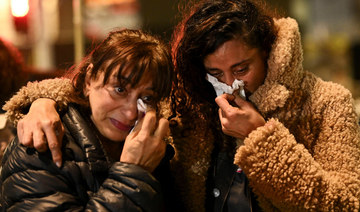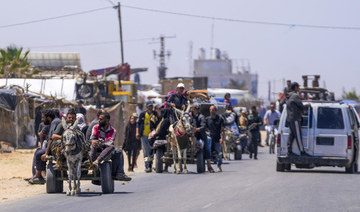GAZA STRIP: Over the last five months, Israel has killed thousands of Hamas fighters, destroyed dozens of their tunnels and wreaked unprecedented destruction on the Gaza Strip.
But it still faces a dilemma that was clear from the start of the war and will ultimately determine its outcome: It can either try to annihilate Hamas, which would mean almost certain death for the estimated 100 hostages still held in Gaza, or it can cut a deal that would allow the militants to claim a historic victory.
Either outcome would be excruciating for Israelis. Either would likely seal an ignominious end for Prime Minister Benjamin Netanyahu’s long political career. And either might be seen as acceptable by Hamas, which valorizes martyrdom.
Netanyahu, at least in public, denies there is any such dilemma. He has vowed to destroy Hamas and recover all the hostages, either through rescue missions or ceasefire agreements, saying victory could come “in a matter of weeks.”
As long as the war rages, he can avoid early elections that polls strongly suggest would remove him from power. But it seems inevitable that at some point a choice will have to be made between the hostages and military victory.
Hamas, meanwhile, appears to be in no hurry to reach a temporary ceasefire ahead of the Muslim holy month of Ramadan, which begins next week, or to delay an expected Israeli operation in Rafah, the southern city where half of Gaza’s population has sought refuge.
Hamas leader Yehya Sinwar, the alleged mastermind of the Oct. 7 attack against Israel, has reason to believe that as long as he holds the hostages, he can eventually end the war on his terms.
SINWAR’S BLOODY GAMBLE
In over two decades spent inside Israeli prisons, Sinwar reportedly learned fluent Hebrew and studied Israeli society, and he identified a chink in the armor of his militarily superior adversary.
He learned that Israel cannot tolerate its people, especially soldiers, being held captive, and will go to extraordinary lengths to bring them home. Sinwar himself was among over 1,000 Palestinian prisoners released in exchange for a single captive soldier in 2011.
For Sinwar, the mass killings on Oct. 7 might have been a horrific sideshow to the main operation, which was to drag large numbers of hostages into a vast labyrinth of tunnels beneath Gaza, where Israel would be unable to rescue them, and where they could serve as human shields for Hamas leaders.
Once that was accomplished, he had a powerful bargaining chip that could be traded for large numbers of Palestinian prisoners, including top leaders serving life sentences, and an end to the Israeli onslaught that Hamas had anticipated.
No amount of 2,000-pound bombs could overcome the strategy’s brutal logic.
Israeli officials say the tunnels stretch for hundreds of kilometers (miles) and some are several stories underground, guarded by blast doors and booby traps. Even if Israel locates Hamas leaders, any operation would mean almost certain death for the hostages that likely surround them.
“The objectives are quite contradictory,” said Amos Harel, a longtime military correspondent for Israel’s Haaretz newspaper. “Of course, you can say it will take a year to defeat Hamas, and we’re moving ahead on that, but the problem is that nobody can ensure that the hostages will remain alive.”
He added that even if Israel somehow kills Sinwar and other top leaders, others would move up the ranks and replace them, as has happened in the past.
“Israel will have a really hard time winning this,” Harel said.
Israel has successfully rescued three hostages since the start of the war, all of whom were aboveground. Israeli troops killed three hostages by mistake, and Hamas says several others were killed in airstrikes or failed rescue operations. More than 100 hostages were released in a ceasefire deal in exchange for Palestinians imprisoned by Israel.
Netanyahu says military pressure will eventually bring about the release of the roughly 100 hostages, and the remains of 30 others, still held by Hamas.
But in candid remarks in January, Gadi Eisenkot, Israel’s former top general and a member of Netanyahu’s War Cabinet, said anyone suggesting the remaining hostages could be freed without a ceasefire deal was spreading “illusions.”
It’s hard to imagine Hamas releasing its most valuable human shields for a temporary ceasefire, only to see Israel resume its attempt to annihilate the group, and Hamas has rejected the idea of its leaders surrendering and going into exile.
For Sinwar, it’s better to stay underground with the hostages and see if his bet pays off.
HOW DOES THIS END?
Netanyahu’s government is under mounting pressure from families of the hostages, who fear time is running out, and the wider public, which views the return of captives as a sacred obligation.
President Joe Biden, Israel’s most important ally, is at risk of losing re-election in November, in part because of Democratic divisions over the war. The humanitarian catastrophe in Gaza has sparked worldwide outrage. The war threatens to ignite other fronts across the Middle East.
There’s a Hamas proposal on the table in which the hostages come back alive.
It calls for the phased release of all of the captives in return for Israel’s gradual withdrawal from Gaza, a long-term ceasefire and reconstruction. Israel would also release hundreds of prisoners, including top Palestinian political leaders and militants convicted of killing civilians.
Hamas would almost certainly remain in control of Gaza and might even hold victory parades. With time, it could recruit new fighters, rebuild tunnels and replenish its arsenals.
It would be an extremely costly victory, with over 30,000 Palestinians killed and the total destruction of much of Gaza. Palestinians would have different opinions on whether it was all worth it.
A rare wartime poll last year found rising support for Hamas, with over 40 percent of Palestinians in the occupied West Bank and Gaza backing the group.
That support would only grow if Hamas succeeds in lifting the longstanding blockade on Gaza, said Tahani Mustafa, senior Palestine analyst at the Crisis Group, an international think tank.
“If this is able to bring some serious concessions that can make life just marginally better, then I think not only will this bolster support for Hamas, but it could also bolster support for armed resistance more broadly.”
Netanyahu has rejected Hamas’ proposal as “delusional,” but there is no sign the militant group is backing away from its core demands.
Israel can keep fighting – for weeks, months or years. The army can kill more fighters and demolish more tunnels, while carefully avoiding areas where it thinks the hostages are held.
But at some point, Netanyahu or his successor will likely have to make one of the most agonizing decisions in the country’s history, or it will be made for them.
The brutal logic of Hamas’ hostage strategy could deny Israel victory in Gaza
https://arab.news/vp24c
The brutal logic of Hamas’ hostage strategy could deny Israel victory in Gaza

- Netanyahu has vowed to destroy Hamas and recover all the hostages, either through rescue missions or ceasefire agreements
- Hamas, meanwhile, appears to be in no hurry to reach a temporary ceasefire ahead of the Muslim holy month of Ramadan
Hamas says Israeli-British hostage held in Gaza dead

Earlier on Saturday, the Ezzedine Al-Qassam Brigades released an 11-second clip showing captive Nadav Popplewell alive and identifying himself.
The Hostages and Missing Families Forum campaign group identified him in a statement.
In the video, the footage was superimposed with text in Arabic and Hebrew that read: “Time is running out. Your government is lying.”
The hostage had a black eye in the clip but showed no other visible signs of injuries.
Wearing a white T-shirt and appearing to speak under duress, he introduced himself as 51-year-old Popplewell, from kibbutz Nirim in southern Israel.
Later on Saturday, Hamas released what appeared to be a full version of the video from which the earlier clip was taken.
Hamas claimed in the video that Popplewell had died on Saturday of his earlier wounds.
“Nadav Popplewell, a British citizen, died today after being seriously injured a month ago (due to Zionist air strikes),” a superimposed text in English said in the video below a picture of the hostage shown in a white photo frame.
“His health deteriorated because he did not receive intensive medical care because the enemy has destroyed the Gaza Strip’s hospitals,” Abu Obeida, the spokesman of the Ezzedine Al-Qassam Brigades, said in a separate statement.
AFP was unable to independently verify the authenticity of the video.
Israeli military spokesman Rear Admiral Daniel Hagari did not mention Popplewell during a televised briefing, but said that troops were still seeking to bring the hostages home.
“Even at this hour, every fighter (soldier) and commander on the battlefield envisions the hostages, sees them, thinks of them, and fights to bring them home,” he said.
Popplewell was kidnapped from his home during Hamas’s October 7 attack along with his mother, Hanna Peri, who was released during a one-week truce in November — the only pause so far in more than seven months of war.
Popplewell’s older brother was killed in the attack.
The video posted Saturday on the Telegram channel of Hamas’s armed wing was the third time in less than a month that the group released footage of captives held in Gaza.
On April 27 Hamas released a video showing two hostages alive — Keith Siegel and Omri Miran.
Three days earlier it broadcast another video showing hostage Hersh Goldberg-Polin alive.
The videos come amid growing domestic pressure on the Israeli government to secure the release of the hostages.
“Every sign of life received from the hostages held by Hamas is another cry of distress to the Israeli government and its leaders,” the families forum said in a statement earlier on Saturday.
“We don’t have a moment to spare! You must strive to implement a deal that will bring them all back today.”
Hundreds of protesters meanwhile gathered in the commercial city of Tel Aviv and in Jerusalem calling to strike a deal for the release of the captives.
Hamas and Israel have so far failed to reach a deal despite repeated rounds of indirect negotiations.
Some 250 people were abducted to the Gaza Strip on October 7 when Hamas militants attacked southern Israel.
Israeli officials say 128 of them are still held captive in the Palestinian territory, including at least 36 who are dead.
The attack resulted in the deaths of more than 1,170 people, mostly civilians, according to an AFP tally based on official Israeli figures.
In Israel’s retaliatory military campaign in Gaza, at least 34,971 people have been killed so far, most of them women and children, according to the Hamas-run territory’s health ministry.
Man killed as Lebanese troops raid people smugglers on Syrian border

- Beirut security plan revealed amid fears of illegal weapons, rising crime
BEIRUT: Lebanon’s Interior Ministry says it will implement a security plan in Beirut in coming days amid fears over the large number of illegal weapons and growing lawlessness in areas of the city and surrounding neighborhoods.
Security forces have been told to recruit 800 extra personnel as part of the clampdown, the ministry said.
The security plan was announced as Lebanon’s General Security Directorate said it is cracking down on Syrian nationals who remain in the country illegally.
The directorate told Syrian nationals who have violated the country’s entry and residence regulations to “regularize their status and leave Lebanese territory” by heading to border departments and centers immediately.
Those who ignore the order will face legal action, the statement warned.
Lebanese Army Command said on Saturday that an army unit, with support from the General Intelligence Directorate, detained several men in an operation targeting people smugglers in Deir Al-Aachayer in the Bekaa region.
A Syrian national who attacked troops with a spear was shot and later died in hospital from his wounds, the army said.
People traffickers and goods smugglers have long been a problem in the area, which overlaps Syrian territory, according to the army.
Authorities are also cracking down on illegal Syrian-owned institutions and shops, as well as businesses that employ foreign workers in violation of regulations and laws.
Media reports said the General Security Directorate will no longer grant residency permits to Syrian family members sponsored by Lebanese citizens in Lebanon.
Lebanon’s caretaker Interior Minister Bassam Mawlawi said during a meeting in Beirut that the Syrian presence “plays a fundamental role in putting pressure on security in Lebanon.”
He said that after “arduous negotiations,” the UN Refugee Agency revealed almost 1.5 million Syrians were in Lebanon “with unclear reasons for their asylum and entry dates.”
However, Lebanon estimates there are at least 2.3 million Syrian refugees in the country, most of whom are “economic refugees, not security or political refugees,” according to Mawlawi.
He said that Lebanon “cannot tolerate any economic asylum.”
Lebanese authorities have urged citizens not to employ, shelter, or provide accommodation for Syrians residing illegally in in the country. Violators face administrative and judicial procedures.
The General Security Directorate also warned Syrian refugees registered with UNHCR against engaging in paid work outside their designated sectors.
In recent months, there has been a sharp rise in the number of murders, kidnappings, and thefts in Lebanon.
Incidents have been particularly prevalent on the road to Beirut Airport and in the border area with Syria, where illegal crossings are common.
According to Interior Ministry statistics, a significant proportion of the perpetrators are Syrian, accounting for nearly 40 percent of the total detainees.
The recent killing of Pascal Sleiman, the coordinator of the Lebanese Forces Party, intensified animosity toward the Syrian presence in Lebanon.
Mawlawi said that Beirut and its suburbs, especially the road to Rafic Hariri International Airport, “will witness a security plan aimed at reassuring the people of Beirut and its residents, and restoring stability.”
The Lebanese government has declared that any Syrian who entered Lebanese territory after 2019 is considered to be illegally present in the country.
It plans to send all those who arrived after 2019 back to Syria, except detainees who may be at risk if they return.
Lebanon received a €1 billion aid package early this month from the European Commission to bolster its border controls and help stem refugee flows to Europe.
The financing will be available from the current year until 2027. However, caretaker Prime Minister Najib Mikati said there was a difference between registered refugees and those who entered Lebanon illegally and are facing deportation.
Mikati held talks in Lebanon in early May with European Commission President Ursula von der Leyen and Cypriot President Nikos Christodoulides. He pushed for recognition from Europe and the international community that most areas in Syria are now safe, which would facilitate refugees’ return home.
Independent MP Ghassan Skaf said the Syrian refugee crisis in Lebanon has become an “existential threat, and there is now a consensus about the issue.”
However, he said that dealing with the problem “must be far from populism and hate speech.”
Hamas releases video of Israeli-British hostage held in Gaza

- The video posted on the group’s Telegram channel and showing the hostage speaking under duress
GAZA: Hamas’s armed wing, the Ezzedine Al-Qassam Brigades, on Saturday released a video of a man held hostage in Gaza by Palestinian militants and seen alive in the footage.
The captive, identified by the Hostages and Missing Families Forum campaign group as Nadav Popplewell, is seen speaking in the 11-second clip, which is superimposed with text in Arabic and Hebrew that reads: “Time is running out. Your government is lying.”
In the video the hostage, who is also a British national, has a black eye and is seen speaking under duress.
He showed no other visible signs of injuries.
Wearing a white T-shirt, he introduces himself as 51-year-old Popplewell, from kibbutz Nirim in southern Israel.
Popplewell was kidnapped from his home during Hamas’s October 7 attack along with his mother, Hanna Peri, who was released during a one-week truce in November — the only pause so far in more than seven months of war.
Popplewell’s older brother was killed in the attack.
The video posted Saturday on the Telegram channel of Hamas’s armed wing was the third time in less than a month that the group releases footage of captives held in Gaza.
On April 27 Hamas released a video showing two hostages alive — Keith Siegel and Omri Miran.
Three days earlier it broadcast another video showing hostage Hersh Goldberg-Polin alive.
The videos come amid growing domestic pressure on the Israeli government to secure the release of the remaining hostages.
“Every sign of life received from the hostages held by Hamas is another cry of distress to the Israeli government and its leaders,” the families’ group said in its statement on Saturday.
“We don’t have a moment to spare! You must strive to implement a deal that will bring them all back today.”
Prime Minister Benjamin Netanyahu and his government are under immense pressure to strike a deal with Hamas, but the two warring sides have so far failed despite repeated rounds of indirect negotiations.
Some 250 people were abducted to the Gaza Strip on October 7 when Hamas militants attacked southern Israel.
Israeli officials say 128 of them are still held captive in the Palestinian territory, including 36 who are dead.
The attack resulted in the deaths of more than 1,170 people, mostly civilians, according to an AFP tally based on official Israeli figures.
In Israel’s retaliatory military campaign in Gaza, at least 34,971 people have been killed so far, most of them women and children, according the Hamas-run territory’s health ministry.
Israel strikes Gaza as more Rafah evacuations ordered

- Fighting is escalating across the enclave with heavy clashes between Israeli troops and Palestinian militants
- Israel’s move into Rafah has so far been short of the full-scale invasion that it has planned
RAFAH, Gaza Strip: Israeli strikes on Saturday hit parts of Gaza including Rafah where Israel expanded an evacuation order and the UN warned of “epic” disaster if an outright invasion of the crowded city occurs.
AFP journalists, medics and witnesses reported strikes from the south to the north of the coastal territory, where the UN says aid is blocked after Israeli troops defied international opposition and entered eastern Rafah this week, effectively shutting two crossings.
At least 21 people were killed during strikes in central Gaza and taken to Al-Aqsa Martyrs Hospital in Deir Al-Balah city, a hospital statement said.
Bodies covered in white lay on the ground in a courtyard of the facility. A man in a baseball cap leaned over one body bag, clasping a dust-covered hand that protruded.
The feet of another corpse poked from under a blanket bearing the picture of a large teddy bear.
In Rafah, witnesses reported intense air strikes near the crossing with Egypt, and AFP images showed smoke rising over the city.
Other strikes occurred in north Gaza, they said.
Israeli troops on Tuesday seized and closed the Palestinian side of the Rafah crossing — through which all fuel passes into Gaza — after ordering residents of eastern Rafah to evacuate.
Israel’s military said it went into eastern Rafah to pursue Palestinian militants.
Fighting continued on the Gazan side of the Rafah crossing, the military reported on Friday, before on Saturday expanding its evacuation order to more areas of Rafah’s east.
Evacuation orders
The new order, posted on social media platform X by military spokesman Avichay Adraee, said the designated areas had “witnessed Hamas terrorist activities in recent days and weeks.”
The war began with Hamas’s unprecedented October 7 attack on Israel, which resulted in the deaths of more than 1,170 people, mostly civilians, according to an AFP tally of Israeli official figures.
During their attack, militants also seized hostages. Israel estimates 128 of them remain in Gaza including 36 whom the military says are dead.
Israel’s retaliatory offensive has killed at least 34,971 people in Gaza, mostly women and children, according to the Hamas-run territory’s health ministry.
A US State Department report on Friday said Israel likely violated norms on international law in its use of weapons from the United States but it did not find enough evidence to block shipments.
The State Department submitted its report two days after President Joe Biden publicly threatened to withhold certain bombs and artillery shells if Israel goes ahead with an all-out assault on Rafah, where the United Nations said 1.4 million had been sheltering.
Israeli Prime Minister Benjamin Netanyahu has pledged to “eliminate” Hamas battalions in Rafah and achieve “total victory,” after the army in January said it had dismantled the Hamas command structure in northern Gaza.
But on Saturday Adraee said Hamas “is trying to rebuild” there, and ordered evacuations from the north’s Jabalia and Beit Lahia areas.
After rising criticism from Washington over the civilian impact of Israel’s war against Hamas, the threat to withhold weapons was the first time Biden raised the ultimate US leverage over Israel — its military aid which totals $3 billion annually.
UN Secretary-General Antonio Guterres said Friday that Gaza risked an “epic humanitarian disaster” if Israel launched a full-scale ground operation in Rafah.
While the army said it reopened Kerem Shalom crossing near Rafah on Wednesday, aid agencies cautioned that getting assistance through the militarised area remained extremely difficult.
Aid in limbo
A UN report late Friday cited Martin Griffiths, the UN’s aid chief, as saying closure of the crossings “means no aid.”
Israel has said its Erez crossing into northern Gaza remains open.
The State Department report said it was “reasonable to assess” that Israel has used American weapons in ways inconsistent with standards on humanitarian rights but that the United States could not reach “conclusive findings.”
The report does not affect Biden’s threat to withhold some weapons.
On Friday the White House said it did not yet see a “major ground operation” in Rafah but was watching the situation “with concern.”
Biden’s administration had already paused delivery of 3,500 bombs as Israel appeared ready to attack Rafah.
More than 100,000 people fled the city after the initial evacuation order, the United Nations said on Friday.
Israel on Saturday gave a figure of 300,000, as more Rafah residents piled water tanks, mattresses and other belongings onto vehicles and prepared to flee again.
Malek Al-Zaza, with a trim grey beard, said he has been displaced three times now during the war and found “no food” and “no water” in central Gaza’s Nuseirat camp where he has returned.
“We only have God looking out for us,” he said.
Humanitarian crisis
Israel said it had delivered 200,000 liters of fuel to Gaza on Friday through Kerem Shalom — the amount the United Nations says is needed every day to keep aid trucks moving and hospital generators working.
Reiterating his calls for a ceasefire, Guterres said: “We are actively engaged with all involved for the resumption of the entry of life-saving supplies — including desperately needed fuel — through Rafah and Kerem Shalom crossings.”
The evacuation order on Saturday told residents to go to the “humanitarian zone” of Al-Mawasi, on the coast northwest of Rafah.
That area has “extremely limited access to clean drinking water, latrines, et cetera,” said Sylvain Groulx, Doctors Without Borders (MSF) emergency coordinator in Gaza.
The army late Friday said rocket fire from Gaza wounded an Israeli civilian in the southern city of Beersheba. It was the first time since December that the city had come under Palestinian rocket attack.
In New York, the UN General Assembly voted overwhelmingly to grant the Palestinians additional rights in the global body and backed their drive for full membership.
Palestinian ambassador to the UN Riyad Mansour said the vote was historic, but Israeli Foreign Minister Israel Katz said the move told Hamas that “violence pays off.”
Hamas says Gaza ceasefire efforts are back at square one

- Israel has killed more than 34,700 Palestinians, according to Gaza’s Health Ministry
CAIRO: The Palestinian militant group Hamas said on Friday that efforts to find a Gaza Strip truce deal were back at square one after Israel effectively spurned a plan from international mediators, and the White House said it was trying to keep the sides engaged “if only virtually.”
Hamas said in a statement it would consult with other Palestinian factions on its strategy for talks to halt seven months of war triggered by its deadly Oct. 7 attack on Israel.
Hours earlier, the United Nations warned that aid for Gaza could grind to a halt in days after Israel seized control this week of the Rafah crossing between Gaza and Egypt, a vital route for supplies to the devastated Palestinian enclave.
Despite heavy US pressure, Israel has said it will proceed with an assault on the southern Gaza city of Rafah, where more than 1 million displaced people have sought refuge and Israeli forces say Hamas militants are dug in.
Israeli tanks captured the main road dividing the eastern and western sections of Rafah, effectively encircling the eastern part of the city in an assault that has caused Washington to hold up delivery of some military aid.
The White House said that it was watching “with concern,” but the Israeli operations appeared to be localized around the shuttered Rafah crossing and did not reflect a large-scale invasion.
“Once again, we urge the Israelis to open up that crossing to humanitarian assistance immediately,” said White House national security spokesman John Kirby.
Israel’s plan for an all-out assault on Rafah has ignited one of the biggest rifts in generations with its main ally. Washington held up a weapons shipment over fears of massive civilian casualties.
In a report to Congress, President Joe Biden’s administration on Friday said it was reasonable to assess that Israel had used US arms in instances “inconsistent” with international humanitarian law.
However, the administration said it still found credible and reliable Israel’s assurances that it will use US weapons in accordance with international humanitarian law.
Indirect diplomacy has failed to end a war that health authorities in Hamas-run Gaza say has killed almost 35,000 people since the Oct. 7 attack. Some 1,200 people were killed in Israel and 253 taken hostage on Oct. 7, according to Israeli tallies.
Ceasefire talks in Cairo broke up on Thursday with no agreement.
Hamas had said it agreed at the start of the week to a proposal by Qatari and Egyptian mediators that had previously been accepted by Israel. Israel said the Hamas proposal contained elements it cannot accept.
“Israel’s rejection of the mediators’ proposal through the amendments it made returned things to the first square,” Hamas said in Friday’s statement.
“In the light of (Israel Prime Minister Benjamin) Netanyahu’s behavior and rejection of the mediators’ document and the attack on Rafah and the occupation of the crossing, the leadership of the movement will hold consultations with the brotherly leaders of the Palestinian factions to review our negotiation strategy.”
“Hamas did not suspend nor withdraw from the negotiations; the occupation (Israelis) turned against the mediators’ proposal,” a senior Hamas official, Khalil Al-Hayya, said in comments to Al Araby TV published by Hamas.
Kirby said the end of the talks — which CIA Director William Burns was helping mediate — was “deeply regrettable,” but the US believed the differences were surmountable.
“We are working hard to keep both sides engaged in continuing the discussion, if only virtually,” he said.
EXPLOSIONS AND GUNFIRE
Residents described almost constant explosions and gunfire east and northeast of Rafah on Friday, with intense fighting between Israeli forces and militants from Hamas and Islamic Jihad.
Hamas said it ambushed Israeli tanks near a mosque in the east of the city, a sign the Israelis had penetrated several kilometers from the east to the outskirts of the built-up area.
Israel has ordered civilians out of the eastern part of Rafah, forcing tens of thousands of people to seek shelter outside the city, previously the last refuge of more than a million who fled other parts of the enclave during the war.
Israel says it cannot win the war without assaulting Rafah to root out thousands of Hamas fighters it believes are sheltering there. Hamas says it will fight to defend it.
Supplies were already running short and aid operations could halt within days as fuel and food stocks get used up, UN aid agencies said.
“For five days, no fuel and virtually no humanitarian aid entered the Gaza Strip, and we are scraping the bottom of the barrel,” said the UNICEF Senior Emergency Coordinator in the Gaza Strip, Hamish Young.
Aid agencies say the battle has threatened hundreds of thousands of displaced civilians.
“It is not safe, all of Rafah isn’t safe, as tank shells landed everywhere since yesterday,” Abu Hassan, 50, a resident of Tel Al-Sultan west of Rafah told Reuters via a chat app.
“I am trying to leave but I can’t afford 2,000 shekels ($540) to buy a tent for my family,” he said. “There is an increased movement of people out of Rafah even from the western areas, though they were not designated as red zones by the occupation.”
Israeli tanks have sealed off eastern Rafah from the south, capturing and shutting the only crossing between the enclave and Egypt. An advance on Friday to the Salahuddin road that bisects the Gaza Strip completed the encirclement of the “red zone” where they have ordered residents out.
The Israeli military said its forces in eastern Rafah had located several tunnel shafts, and troops backed by an air strike fought at close quarters with groups of Hamas fighters, killing several.
It said Israeli jets had hit several sites from which rockets and mortar bombs had been fired toward Israel.
The UN General Assembly overwhelmingly backed a Palestinian bid to become a full UN member by recognizing it as qualified to join and recommending the UN Security Council “reconsider the matter favorably.”





















